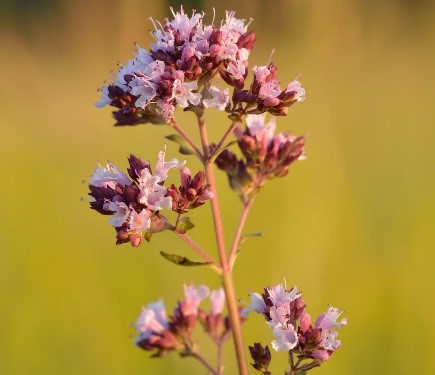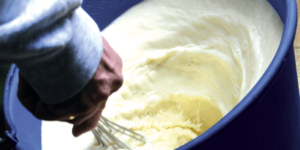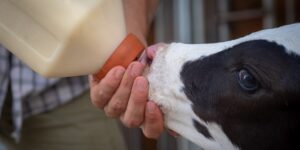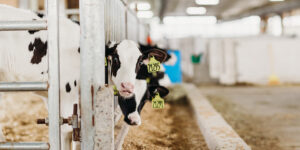It’s all natural! What can oregano oil do for your calves?
Proven to be a valuable part of young animal nutrition
The natural world is an incredible source of beneficial and powerful compounds that can support health and performance of animals and humans alike. Many uses of plant extracts date back to early civilisations. In the time of the Greeks, oregano oil was used to treat all kind of ailments. Plant extracts (essential oils) like oregano, are commonly used in animal husbandry practices as well. About 20 years ago, the first study on the use of natural oregano oil in young animal nutrition started at Denkavit. As a result, many of our products contain natural oregano oil. Not only because of its pleasant herbal smell but also for its benefits on animal health and performance. Since the inclusion of oregano oil in our milk replacers, less bloating (mainly in small ruminants) and a reduced diarrhea rate have been reported by producers. But how does this work?
Naturally produced
Oregano oil is a natural product sourced from the Origanum vulgare plant, which is bred and cultivated to provide a complete and balanced product. Through steam distillation, no chemicals are added and the oil is extracted from the leaves and standardized through gas chromatography. This results in a consistent high-quality product with guaranteed levels of active components.
Antibacterial activity
In vitro research shows strong inhibitory effects of oregano on pathogens like E. coli, Clostridia and Salmonella, much stronger than rosemary and thyme for instance1. Even compared to commonly used antibiotics, like Neomycin, oregano oil provides more effective inhibition of microbial growth of E. coli and Salmonella2. In another study with calves, oregano oil proved to be as effective in reducing E. coli diarrhea as compared to Neomycin3.
Active components
It is no single component in oregano oil that provides these effects. More than 30 different compounds in the oil work together in a synergistic manner. The main components of oregano oil, carvacrol and thymol, were compared to the complete natural oregano oil, and the natural oil showed greater antimicrobial effects4. The antimicrobial activity is mainly attributed to the ability of the compounds to damage bacterial cell walls. When the cell walls of the bacterium are broken, metabolites will leak and the cells become weak, therefore reducing the infection pressure 4 5 6 7. Oregano oil in the milk replacer can also reduce bacterial growth (spoilage) in our milk replacers products after mixing, especially in less hygienic situations.
Anti-microbial effects
There is more to oregano oil than just antimicrobial activity, although less researched there is also a known antioxidant8, antiviral9 and antifungal effect10. Oregano oil additionally showed a reduction in Cryptosporidium parvum presence11, which we all know can pose a large threat to the health of young ruminants.
Most of the strong anti-microbial effects of oregano oil are obtained using high dosages, which are not suitable in a milk replacer. Using natural oregano in the milk replacer is still effective in supporting a balanced microbial population in the gut and other indirect benefits such as reducing neonatal diarrhea12, increasing solid feed intake, improving digestion and therefore acting as a growth promotor13 14 15. In a practical trial performed on a commercial dairy farm oregano oil was evaluated as a natural alternative to antibiotics in calf milk replacer. Results showed that oregano oil was even more effective in reducing diarrhoea and loose feces incidence compared to the antibiotics.
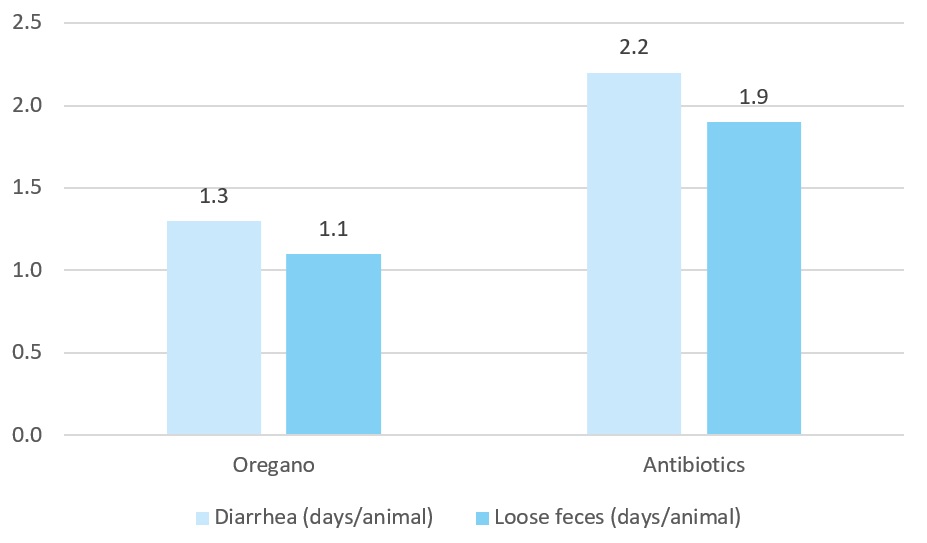
Conclusion
The synergistic action of over 30 components within our natural oregano oil is well researched and has been proven for more than 20 years to be a valuable addition to our milk replacers. Natural oregano oil supports excellent health and optimal performance of young ruminants to raise productive and healthy animals.
Sources
- Hammer, K. A., Carson, C. F., & Riley, T. V. (1999). Antimicrobial activity of essential oils and other plant extracts. Journal of applied microbiology, 86(6), 985-990.
- Elgayyar, M., Draughon, F. A., Golden, D. A., & Mount, J. R. (2001). Antimicrobial activity of essential oils from plants against selected pathogenic and saprophytic microorganisms. Journal of food protection, 64(7), 1019-1024.
- A. Bampidis, V. Christodoulou, P. Florou-Paneri and E. Christaki (2006). Effect of Dried Oregano Leaves Versus Neomycin in Treating Newborn Calves with Colibacillosis.. Vet. Med. A 53, 154–156
- Cristani, M., D’Arrigo, M., Mandalari, G., Castelli, F., Sarpietro, M. G., Micieli, D., … & Trombetta, D. (2007). Interaction of four monoterpenes contained in essential oils with model membranes: implications for their antibacterial activity. Journal of agricultural and food chemistry, 55(15), 6300-6308.
- Helander, I. M., Alakomi, H. L., Latva-Kala, K., Mattila-Sandholm, T., Pol, I., Smid, E. J., … & von Wright, A. (1998). Characterization of the action of selected essential oil components on Gram-negative bacteria. Journal of agricultural and food chemistry, 46(9), 3590-3595.
- Lambert, R. J. W., Skandamis, P. N., Coote, P. J., & Nychas, G. J. (2001). A study of the minimum inhibitory concentration and mode of action of oregano essential oil, thymol and carvacrol. Journal of applied microbiology, 91(3), 453-462.
- Sara Burt (2004) Essential oils: their antibacterial properties and potential applications in foods—a review.. International Journal of Food Microbiology 94, 223– 253
- Bakkali, F., Averbeck, S., Averbeck, D., & Idaomar, M. (2008). Biological effects of essential oils–a review. Food and chemical toxicology, 46(2), 446-475.
- Pilau, M. R., Alves, S. H., Weiblen, R., Arenhart, S., Cueto, A. P., & Lovato, L. T. (2011). Antiviral activity of the Lippia graveolens (Mexican oregano) essential oil and its main compound carvacrol against human and animal viruses. Brazilian Journal of Microbiology, 42, 1616-1624.
- Adam, K., Sivropoulou, A., Kokkini, S., Lanaras, T., & Arsenakis, M. (1998). Antifungal activities of Origanum vulgare subsp. hirtum, Mentha spicata, Lavandula angustifolia, and Salvia fruticosa essential oils against human pathogenic fungi. Journal of Agricultural and Food Chemistry, 46(5), 1739-1745.
- Gaur, S., Kuhlenschmidt, T. B., Kuhlenschmidt, M. S., & Andrade, J. E. (2018). Effect of oregano essential oil and carvacrol on Cryptosporidium parvum infectivity in HCT-8 cells. Parasitology international, 67(2), 170-175.
- Katsoulos, P. D., Karatzia, M. A., Dovas, C. I., Filioussis, G., Papadopoulos, E., Kiossis, E., … & Karatzias, H. (2017). Evaluation of the in-field efficacy of oregano essential oil administration on the control of neonatal diarrhea syndrome in calves. Research in veterinary science, 115, 478-483.
- Li, P., Piao, X., Ru, Y., Han, X., Xue, L., & Zhang, H. (2012). Effects of adding essential oil to the diet of weaned pigs on performance, nutrient utilization, immune response and intestinal health. Asian-Australasian journal of animal sciences, 25(11), 1617.
- Cho, J. H., Chen, Y. J., Min, B. J., Kim, H. J., Kwon, O. S., Shon, K. S., … & Asamer, A. (2005). Effects of essential oils supplementation on growth performance, IgG concentration and fecal noxious gas concentration of weaned pigs. Asian-Australasian Journal of Animal Sciences, 19(1), 80-85.
- Manzanilla, E. G., Nofrarias, M., Anguita, M., Castillo, M., Perez, J. F., Martin-Orue, S. M., … & Gasa, J. (2006). Effects of butyrate, avilamycin, and a plant extract combination on the intestinal equilibrium of early-weaned pigs. Journal of animal science, 84(10), 2743-2751.



